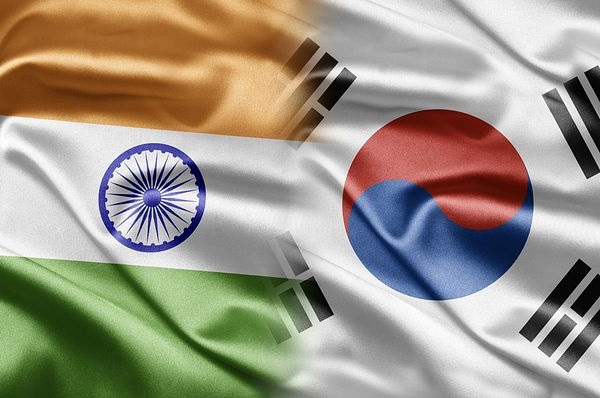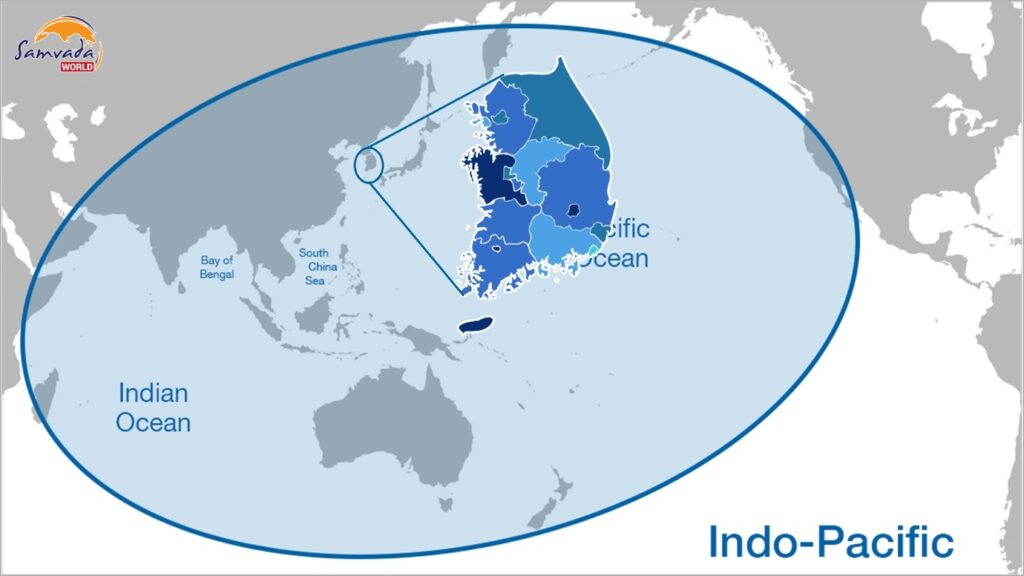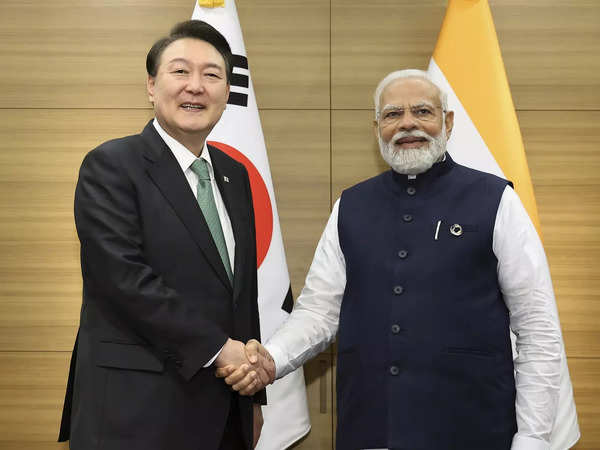|
Getting your Trinity Audio player ready...
|

- South Korea-India economic equations hark back to the Comprehensive Economic Partnership Agreement, however, despite the priority underscoring rhetorical flourish across four successive administrations, has struggled to institutionalise higher-order scope and trajectory in relations.
- South Korea must also harness the deep advantages that accrue from a markedly youthful Indian demography and its reservoir of intellectual capital by delimiting migration and tenured mobility possibilities.
- The ROK’s Indo-Pacific orientation proffers a template and platform to amplify its profile, role and visibility.
It’s nothing short of a truism to aver that, the global centre of gravity has transitioned away from the Euro-Atlantic vector to the Indo-Pacific expanse, observed in metrics of demographics, trade and investment flows, technological trajectories, etc. This phenomenon is marked no less, by the multitude of resident and non-resident major and middle powers, crafting independent Indo-Pacific strategies and calibrating respective strategic calculus, contextualised, to the mutating balance of power.
The Republic of Korea (ROK), with its unveiled ‘Strategy for a Free, Peaceful and Prosperous Indo-Pacific’ (SFPPIP) in December 2022, is the latest protagonist to the bandwagon, but far from being a laggard, the enunciation represents a refreshing injection of broad-sheet dynamism, to the already pluralising sovereign geostrategic indulgence, of the region.
South Korean Embrace of the Indo-Pacific: Above and Beyond the New Southern Policy (NSP)
The roll-out of Seoul’s marquee ‘Indo-Pacific’ Vision, though bearing the full-on imprimatur of incumbent President Yoon Suk Yeol and lacking a veritable bipartisan national consensus for now, nevertheless, addresses a trinity of persisting infirmities, which have blighted South Korean foreign policy over the years.
Firstly, it attempts to propel the East Asian nation, out of its singular obsessive focus on existentialism vis-à-vis its neighbour to the North, something that has kept it sub-regionally ensconced, besides, expending an overwhelming extent of its diplomatic oxygen and precious political capital.
Secondly, it endeavours to yank itself, out of the overbearing straitjacket of US-China competition, to which it has remained in-subordinated, for albeit compelling security and economic reasons, consequently remaining circumscribed and dimmed, in its broader aspirations.
Thirdly, through its envisaged proclaim of a potential ‘Global Pivotal State’ (GPS), it seeks to ameliorate the modest extent of social power that Seoul beholds, by crafting a slew of “economically and technologically replete strategic partnerships”, serving to build pan-Asian politico-diplomatic socialisation, growing national salience and sovereign credence as a developmental actor, ensuring sovereign risk-diversification through multi-alignment, and enabling the provisioning of public goods, consonant with the remit of a stellar robust spread-sheet of industrial, technological, infrastructural, innovation core-competencies.

This said, the enjoined vision, though perceived in some quarters, as incremental growing-on-the-dial, drawing on predecessor President Moon Jae-in’s New Southern Policy (NSP), is however, qualitatively distinct. If the NSP was a deliberate step-out to cultivate traditional partners across South East Asia and Asia-Pacific coordinates in particular, the SFPPIP consciously steps-up ambitions across the Indo-Pacific straddle, even coveting an ostensibly global playfield, described as excessively adventurist by some, but comprehended by the many, as ventilating much-vaunted plausible national ambitions, at long last.
Where the NSP, sweepingly lumped eclectic South and South East Asia into one composite mix, the Indo-Pacific vision in vogue, construes as specificity-deferent, in not only recognising South Asia as a separate emerging locale, but more importantly, identifies the vibrant rising power India as a cogent and tangible peer-partner, for comprehensively ramped-up bilateral ties, as also for its benign beneficent involvement, in the Indian Ocean Region, and the littoral stretch of Eastern Africa.
If the NSP was a deliberate step-out to cultivate traditional partners across South East Asia and Asia-Pacific coordinates in particular, the SFPPIP consciously steps-up ambitions across the Indo-Pacific straddle.
The freshly minted Indo-Pacific strategy is opportune in that it fructifies at a time when a top-ten headlining economy South Korea, finds itself increasingly incorporated at strategic high-tables, from being a standing invitee to the G-7 constellation, an integral participant in the informal ‘MIKTA’ cohort, and even averred to being part of a proverbial ‘T-10’, surmised as requisite, in the wake of predatory Chinese techno-nationalism.
South Korea’s ‘Indo-Pacific’ Gambit: Chimes and Aligns with India
Nowhere would the impulses conditioning ROK’s nascent Indo-Pacific template, converge greater and better, than with India. Akin to Seoul, New Delhi has long grappled with the predicament of a fetish over Pakistan that relegated its foreign policy and diplomacy greatly hemmed in, only for the refreshing pivot to consummate, during the present Modi dispensation.
India, since its economic recast away from erstwhile socialist moorings, has inserted itself within regional and global architectures but has abidingly been shorn of adequate integration within normative and productive institutional structures and processes. And despite its continually proven prowess in dimensions of human-tech and innovation, it’s been arduous to establish pedigree as a tangible and credible provider of public goods, even in contiguous and extended Southern Asia.
While these features meld New Delhi and Seoul, what should fuse them further, is their middle powers-oriented article of faith, reposed in practising calibrated deterrence and pragmatic engagement with China but practising nifty economic and technological rebalancing, and preferring soft-hedging between Washington and Beijing, sentient of the fact that commercial tie-ins with the Middle Kingdom, aren’t structurally reversing course in a hurry.
Unless inevitable, staving off crass militaristic mechanisms, for their innate antagonism, exclusivity, predatory and reductionist hue, is primordial in Seoul and New Delhi’s calculus, as they are broadly sold on fashioning a strategic compact, which is not underpinned by an ‘anti-China’ orientation, but undergirded by a conviction, in advancing a stark ‘non-China’ approach.
Forging a South Korea-India Strategic Compact for the Indo-Pacific: Vistas and Verticals

South Korea-India economic equations hark back to the Comprehensive Economic Partnership Agreement (CEPA) 2009-10, however, despite the priority underscoring rhetorical flourish across four successive administrations, has struggled to institutionalise higher-order scope and trajectory in relations. Unlike Japan, South Korea hasn’t been a formidable investor in Indian cross-sectional public sector projects, its corporate footprint limited to a few majors headlining competitive automotive and consumer appliances sectors, and its guarded disposition in respect of stake-holding within back-end industry integration, vide SMEs/MSMEs, even in avenues of Indian cost competitiveness, belies logic and reason.
However, Seoul is bullish on the medium to long-term growth horizon of India, keen as mustard to diversify export destinations beyond China, targeting investor penetration into Global South milieus of South Asia, West Asia, and Africa, and evincing interest to proactively shape the five strategic dimensions driving Indo-Pacific geopolitical geo-economics, viz., critical and emerging technologies, benignity of spatial commons, supply chain diversification for resilience, hard and soft wired infrastructure, and peoples’ centric globalisation through human comity driven innovation.
These are the strategic commanding heights, the Quad constellation has proclaimed for itself, and ROK’s public pronouncement of a desire to join the fold, though spooking many at home, must be viewed as embracing, arguably the Indo-Pacific comity’s most influential grouping, manoeuvring to geo-economics.
India, since its economic recast away from erstwhile socialist moorings, has inserted itself within regional and global architectures but has abidingly been shorn of adequate integration within normative and productive institutional structures and processes.
With India on an upswing in addressing its gaping deficiencies, whether in winnowing dependencies and vulnerabilities across rudimentary or sophisticated industrial manufacturing through the much-touted PLI scheme, a bottom-up scaling of its digital public infrastructure, or instituting a fiscal channel for sustained infra-financing, or for that matter it’s clear-eyed stake-out in start-up innovation, semi-conductor hub creation, renewable energy development, or simply the multi-modal logistics based and urbanisation inducing infrastructure, it procreates opportunities for the broad spectrum of South Korean companies. South Korea can contribute to underwriting a higher-order Indian socio-economy in financial and operational terms, by leveraging its hard capacity ecosystems and attendant expertise in specific human excellence realms, which extend to but are not confined to the foregoing domains.
South Korea with its pertinent pioneering streak can wittingly partake in India’s ambitious port-modernization, island development, blue economy, and decarbonized green-shipping initiatives, which augment New Delhi’s national power for domestic harness and leverage in the extant, and pitches Seoul, as a veritable stakeholder in the India growth story, much in the mould of Japan, US, European countries and the EU, assorted ASEAN countries, and the ilk.
Correspondingly, South Korea must also harness the deep advantages that accrue from a markedly youthful Indian demography and its reservoir of intellectual capital by delimiting migration and tenured mobility possibilities, besides addressing genuine Indian expectations, at extending ostensibly opportunistic market-tapping strategy to developing supply chains.
The ROK’s Indo-Pacific orientation proffers a template and platform to amplify its profile, role and visibility. The deliberate identification of relations with India, as primed for substantive and integrated development, augurs well for deepening the bilateral quotient of this engagement, but also to position South Korea-India synergies, as a cornerstone within the rebalancing strategic framework of the region.
(Dr. Dattesh D. Parulekar is a faculty at the School of International and Area Studies, Goa University. Views expressed at strictly personal.)
